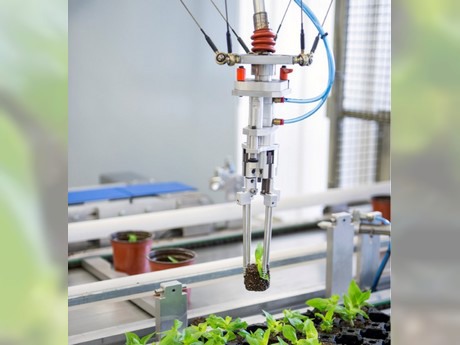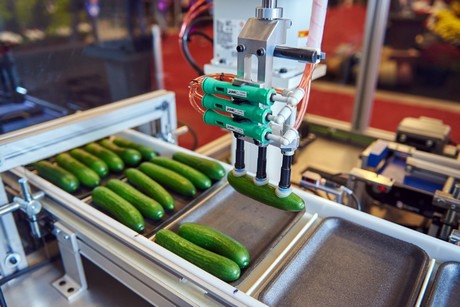Since June 1st the Canadian minimum wage rose again. Nowadays in Ontario, $14 per hour is what has to be paid minimally. Even with the higher wages, there remains a shortage in labour making it difficult for growers to fill all available positions. Because of this, it might not come as a surprise that growers are on the lookout for automation solutions. There are challenges though. “Companies outside the horticulture sector don’t always have the full picture of what they need to look out for when automating in this industry,” says Omar Abdelzaher with Vineland Research and Innovation Centre (Vineland). In order to bridge this gap, the research centre is launching a new venture into automation to provide custom systems integration services for Canadian horticulture companies and help increase productivity and operations efficiencies. “We understand the particular requirements for growers.”
Labour, automation, labour, automation
At $14 per hour, the minimum wage in Ontario has risen significantly over the last couple of years and even though the current wage is frozen until 2020, it will continue to increase up to $15 per hour after that. The situation is no different in other parts of Canada: wages have also risen in the last couple of years in other provinces. No wonder growers looking to lower their costs take a serious look at their workload and automation solutions. “Labour always comes in as number one or number two for production costs,” says Omar Abdelzaher with Vineland. “It gets harder for growers to compete with imports where countries’ wages are lower comparatively.”
There is not only the high cost of labour to deal with, but there is also a shortage in getting labour, both long-term and seasonal. “It is hard to find workers in general, let alone skilled ones,” says Omar. “People who know your product, your system, and continue to work for you – as you need them every year.” Even with the help of temporary foreign worker programs and higher wages, a difficulty remains in filling all positions.
All of this leads to a high demand in automation, and growers are willing to invest. There are a lot of repetitive processes at a typical facility where automation can be used. “For example, palletizing requires to do many similar motions and presents ergonomic problems for workers. Also, pick and place operations like packaging facilities can be automated”, Omar says. “Growers will be happy with a solution as long as it remains reliable and will not affect their production. Downtime and tricky machines to operate are deal breakers.“
Indeed – there’s a serious market for automation suppliers in Canada. However, there are challenges as well. The robotics team at Vineland has been focusing on a long-term research program in automation, and according to Omar, growers from across the country have been approaching Vineland to inquire about automation. “They’ve asked whether we knew a good supplier or vendor, or if we were working on, or could help with automation. This incredible demand from Canadian growers showed us that there is a need for expert assistance, even in helping them to get connected with available technology.”

“At the moment Canadian growers often resort to buying machines from other countries and paying extra for shipping and customs in order to get a solution that they can trust”. Helping these growers find local solutions, that are less expensive, provide good payback and are more suited to their needs is the goal for Vineland.
“We found in Canada that there is a lack of systems integrators with a horticultural focus. There are local automation players from other industries like automotive, but they lack the experience in horticulture, especially when it comes to systems integration. For example: they do palletizing, but they do not necessarily understand how a robot can interfere with fresh produce, or how any kind of collision can damage the product. As a solution, many growers go to overseas machine suppliers. They have to pay extra for shipping and customs, and getting service from overseas can result in longer downtime in case of technical issues. We want to offer them a more local solution with prompt technical support”, Omar explains.
And that’s exactly what they are doing. The Vineland team created a new venture into automation, providing custom systems integration services for Canadian horticulture companies. Helping these growers to find local solutions that are less expensive and more suited to their needs is the goal for Vineland.
“We understand growers’ requirements and we can help optimize a better solution”, Omar says. “Currently a grower may not be able to purchase each individual parts of the automation solution from one vendor. It depends on the complexity of the project, but quite often automation will be a multi-vendor project,” says Omar. “Our function is to understand the requirements and communicate more clearly the needs of the grower to the suppliers.”
Besides offering consultancy, the team also implements automation projects. Recently Vineland launched their first machine, working with Ontario-based CMP Automation. The machine packs mini cucumbers. The robotic loader can replace manual labour by placing greenhouse mini cucumbers onto trays. The machine has been on the market since early this year. After cucumbers have been sorted according to specifications like diameter and length, the system uses machine vision to identify the curvature of each cucumber and places them all in the same direction so they are nestled evenly onto the tray. According to Omar, “CMP has been a strong partner on this project; they brought a deep skill set and experience in automation, and we added the horticultural component. Dealing with delicate, food products with a lot of variability is something that we understand how to do.”

While the systems integration program focuses on connecting growers to quickly-deployed solutions, Vineland also has some long-term research projects on the go. For example, in one project, new research focuses on automating greenhouse cucumber harvesting, with a system that will include a vision component to identify the cucumbers, artificial intelligence to decide whether or not to harvest, and a robot arm to grip and pick the cucumbers.
“Harvesting, in particular, is very challenging,” says Omar. “But it is the focus of a longer research project here, and we are working hard to come up with good solutions. For systems integration projects, the focus is particularly on off-shelf and quickly-built custom solutions such as: grading, sorting, packaging, palletizing, and transplanting. That’s how we can help growers in the short term, and with solutions created nearby, suited exactly to their needs. At the same time, we’re lucky to have the whole team here at Vineland, with a breadth of knowledge across the biology, market and engineering aspects of horticulture. We can apply extra capacity and creativity to solving automation problems by drawing upon this unique group of expertise.”
For more information: Vineland Research and Innovation Centre
Vineland Research and Innovation Centre
vinelandresearch.com
